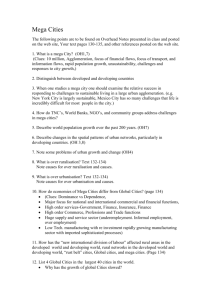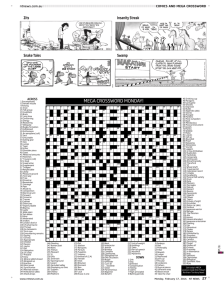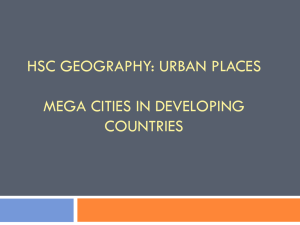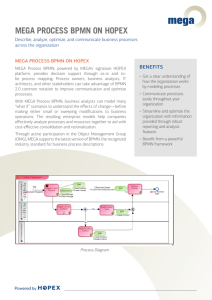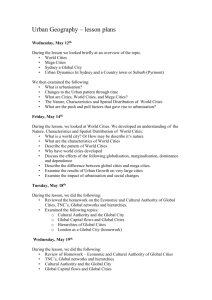ENGINEERING AND C B
advertisement
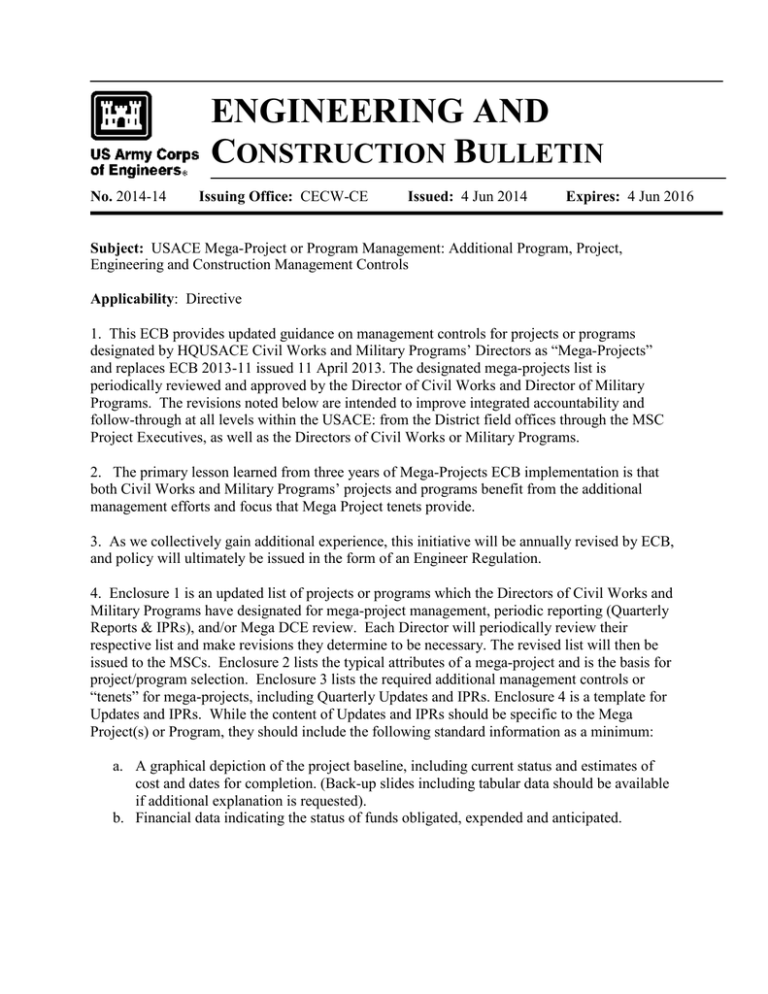
ENGINEERING AND CONSTRUCTION BULLETIN No. 2014-14 Issuing Office: CECW-CE Issued: 4 Jun 2014 Expires: 4 Jun 2016 Subject: USACE Mega-Project or Program Management: Additional Program, Project, Engineering and Construction Management Controls Applicability: Directive 1. This ECB provides updated guidance on management controls for projects or programs designated by HQUSACE Civil Works and Military Programs’ Directors as “Mega-Projects” and replaces ECB 2013-11 issued 11 April 2013. The designated mega-projects list is periodically reviewed and approved by the Director of Civil Works and Director of Military Programs. The revisions noted below are intended to improve integrated accountability and follow-through at all levels within the USACE: from the District field offices through the MSC Project Executives, as well as the Directors of Civil Works or Military Programs. 2. The primary lesson learned from three years of Mega-Projects ECB implementation is that both Civil Works and Military Programs’ projects and programs benefit from the additional management efforts and focus that Mega Project tenets provide. 3. As we collectively gain additional experience, this initiative will be annually revised by ECB, and policy will ultimately be issued in the form of an Engineer Regulation. 4. Enclosure 1 is an updated list of projects or programs which the Directors of Civil Works and Military Programs have designated for mega-project management, periodic reporting (Quarterly Reports & IPRs), and/or Mega DCE review. Each Director will periodically review their respective list and make revisions they determine to be necessary. The revised list will then be issued to the MSCs. Enclosure 2 lists the typical attributes of a mega-project and is the basis for project/program selection. Enclosure 3 lists the required additional management controls or “tenets” for mega-projects, including Quarterly Updates and IPRs. Enclosure 4 is a template for Updates and IPRs. While the content of Updates and IPRs should be specific to the Mega Project(s) or Program, they should include the following standard information as a minimum: a. A graphical depiction of the project baseline, including current status and estimates of cost and dates for completion. (Back-up slides including tabular data should be available if additional explanation is requested). b. Financial data indicating the status of funds obligated, expended and anticipated. ECB No. 2014-14 Subject: USACE Mega-Project or Program Management: Additional Program, Project, Engineering and Construction Management Controls c. Project specific metric (tabular and graphical) analysis and trends. d. Analysis of trends for cost & schedule performance and quality, including corrective actions. e. A summary level update report on any outstanding issues identified by Mega DCE(s). f. If it is a Mega Program, there needs to be an over-arching roll-up of the above items at the program level. 5. MSCs are required to implement the management controls at enclosure 3 for the listed projects/programs effective immediately. CECW-CE (Construction Branch) will coordinate with HQUSACE Offices and the cognizant MSC to schedule HQ-led Mega DCE for these projects. The HQUSACE Chief of Construction is responsible for reviewing the proposed Mega PgMP and/or Mega PMP and (working with other HQ elements) providing guidance to the MSCs on the scope and responsibilities for evaluation and periodic reporting (IPRs) to HQs for each Mega Project. The HQ-led Mega DCE team is normally led by the Senior Construction Manager, CECW-CE (Construction Branch). The Quarterly Reports and/or IPRs will serve to keep HQUSACE Offices updated. 6. The points of contact for implementation of this Mega-Project Management ECB are Mr. Robert Rizzieri, P.E., PMP or Mr. James Moore, P.E., CCM. Encls //S// RICHARD A. HANCOCK Chief, Programs Integration Division Directorate of Military Programs //S// MARK L. MAZZANTI Chief, Programs Integration Division Directorate of Civil Works //S// JAMES C. DALTON, P.E., SES Chief, Engineering and Construction Division U.S. Army Corps of Engineers 2 USACE MEGA PROJECTS LIST AS OF 28 MAY 2014 Civil Works No. MSC Program Project Name Senior Project Project or Project Phase Executive CELRD Project(s) OLMSTED LOCK AND DAM Mr. Dale Design and Construction HQUSACE-led Status and Schedule Completed 2012 - 2015 Follow - Up 2. CELRD Project 3. CELRD Project Completed Sept 2013 - 2015 Follow - Up Completed Sept 2013 - 2015 Follow - Up 4. CELRD Project 1. EAST BRANCH DAM Mr. Dale SAFETY MODIFICATIONS CENTER HILL DAM SAFETY Mr. Dale MODIFICATIONS Procurement Construction Various 5. BLUESTONE DAM SAFETY Mr. Dale MODIFICATIONS CELRD Project(s) MONONGAHELA RIVER Mr. Dale LOCKS AND DAMS 2, 3 AND 4 6. CEMVD Program HURRICANE STORM Mr. Belk DAMAGE RISK REDUCTION SYSTEM (HSDRRS) Various 7. CEMVD Project PCCP NEW ORLEANS CANAL PUMP STATIONS Mr. Belk Design and 2014 Construction 8. CENAD Program Mr. Leach Various 9. CENAD Project HURRICANE SANDY RESTORATION PROGRAM NORFOLK HARBOR, CRANEY ISLAND EXPANSION Mr. Leach Construction TBD (2016) 10. CESAD Program EVERGLADES RESTORATION (CERP) Mr. Lee Various 11. CESAD Project(s) HERBERT HOOVER DIKE Mr. Lee Study, Completed April 2013 Design, & - 2015 Follow - Up Construction 12. CESAD Project Dr. McCallister Planning 13. CESPD Project(s) JFP-FOLSOM Mr. Calcara 14. CESPD Project Mr. Calcara 15. CESWD Project Enclosure 1 SAVANNAH HARBOR EXPANSION PROJECT ISABELLA DAM Design and TBD (2016) Construction 2014-15 2014 2016 TBD (2016) Design and Completed 2012/2013 Construction - 2015 Follow - Up Design 2015 BUFFALO BAYOU (ADDICKS Mr. Slockbower Various AND BARKER) DAM SAFETY MODIFICATIONS 1 2015 2015 Military Programs No. MSC Senior Project Project HQUSACE-led Phase Status and Schedule Executive Mr. Dale Construction TBD (2016) – Remedial Action Mr. Leach Design Virtual (with CENAD) 2014 or 2015 4. Program Project Name or Project CELRD Project SHALLOW LAND DISPOSAL AREA (SLDA) – FUSRAP, ON HOLD CENAD Project RHINE ORDNANCE BARRACKS MEDICAL CENTER INTEGRATED CYBER CENAD Project CENTER JOINT OPERATIONS CENTER – US CYBERCOM CENAD Project USMA CADET BARRACKS 5. CENAD Project 6. CENAD Project 7. 1. 2. Mr. Leach Construction 2015 Mr. Leach Procurement 2014 DATA CENTER EAST CAMPUS (HPCC 2) FORT MEADE MISSLE DEFENSE – ROMANIA Mr. Leach Construction 2015 Mr. Leach Procurement, TBD Construction CENWD Project STRATCOM Dr. Hearn Construction Completed May 2013 - 2015 Follow - Up 8. CENWD Project FT. RILEY HOSPITAL Dr. Hearn 9. CEPOD Program CAMP HUMPHREYS (YRP & LPP) Mr. Ban 10. CEPOD Project KOREA AIR SPACE OPS Mr. Ban Construction Completed Sept 2012 - Follow – Up TBD Planning, TBD Design, & Construction Programming 2015 11. CEPOD Project KINNICK HIGH SCHOOL Mr. Ban Planning 12. CEPOD Project MISSLE DEFENSE – JAPAN Mr. Ban Construction TBD 13. CEPOD Project FUTENMA MCAS RELOCATION Mr. Ban Planning, Design, & Construction 14. CESPD Project FT. IRWIN MEDICAL CENTER FORT HOOD and BLISS HOSPITALS Mr. Calcara Construction 2015 3. 15. CESWD Projects Enclosure 1 TBD TBD Mr. Slockbower Construction 2014 2 Typical Attributes of a Mega-Project 1. Cost and Duration -- The cost of the project or program is one of the most significant attributes of a mega-project. Very large dollar value projects and programs generally represent more risk in achieving project objectives. Performance periods for mega- projects are generally longer indicating more performance risk. 2. Uniqueness -- One of a kind projects or projects involving unique and highly complex systems, processes and technical challenges may be characteristic of mega-projects. 3. Acquisition Strategy and Delivery Method – The contract type, solicitation, evaluation, and compensation methods allocate risk between the contracting parties. The spectrum ranges from simple design-bid-build, firm fixed price (FFP) construction contracts to best value or qualifications-based design or design-build contracts. More complexity and pricing flexibility are characteristic of mega projects. 4. National Significance – Projects or programs of national or international significance may be characteristic mega-projects. An example would be projects constructed under the Dam Safety Modification Program. 5. Critical Nature of Completion Date and/or Funding Constraints – Projects or programs with completion dates established in law or treaty; tight or incremental funding requirements; and/or other requirements which dictate close control and projection of ultimate cost and completion, may be mega-projects. 6. Coordination of Multiple Prime Contractors – Projects or programs that require USACE coordination of multiple prime construction contractors conducting significant construction operations concurrently on a project site may be characteristic mega-projects. 7. Coordination of Multiple Design Agents and Stakeholders – Projects or programs requiring the coordination of multiple design agents, multiple USACE Districts and Centers, or multiple Federal agencies, may be characteristic of mega-projects. 8. Overlapping or Dependent Project Phases – Projects where authorization, funds, or physical constraints determine the pace of execution may be characteristic mega-projects. Enclosure 2 Mega- Project Management Controls These 12 tenets of mega-project management control are intended to be flexible and scalable to accommodate the type, size, and focus of programs and projects. Multiple mega- projects, being accomplished under the same program and/or MSC can be aggregated and managed collectively. Detailed discussion of each tenet will be included in an enhanced Project Management Plan (PMP) or Program Management Plan (PgMP). 1. Establish Disciplined and Focused Supplemental Governance Structure A three-tiered governance structure will be established for mega-projects in order to achieve needed accountability, visibility, understanding, and timely decision-making in order to assure effective communication and issue resolution at appropriate levels. CII defines project culture as “the degree to which (1) project leadership is defined, effective, and accountable; (2) communication within the team and with stakeholders is open and effective; and (3) the team fosters trust, honesty, and shared values.” • The senior level is the Senior Executive Board composed of senior leaders from all stakeholders. The typical member is a GS-15/SES and the contractor’s corporate senior vice president or equivalent. HQUSACE Senior Leaders and HQUSACE Engineering and Construction senior engineers will serve in an advisory role on significant items, to the mega-project’s Senior Project Executive who is the MSC’s designated SES. • The mid-level Executive Leadership Team is composed of GS 13/14 and corporate vice president level staff. This team is composed of the senior leaders responsible for day to day operations at the project site. They are responsible and accountable to make decisions and apply resources to solve problems that rise above the typical dayto-day management of the project. • The working-level Project Leadership Teams are the working level teams assigned to each major phase of the project. This is the level where the typical day-to-day management and engineering work is performed. This three-tiered governance structure for designated mega-projects will be incorporated in program management plans (PgMPs) and project management plans (PMPs) and recognized and supported by the entire vertical team for the mega-project. The governance structure may be adjusted to accommodate differences in programs, command structures and funding between Civil Works, Military, and Host Nation Programs, etc. Additional elements may be added where other customer and USACE elements (including CX, CoS, IWR, RMC, HNC, other Design and Production Centers) are involved. Normally the program and project managers of a Mega Program or Project will report to the executing District and MSC’s Command Structure. 2. Facilitated Partnering -- Professionally facilitated formal partnering will be an integral element of this mega-project governance process. This requirement is not limited solely to contractors and includes facilitated partnering among USACE elements. The following elements of partnering are vital and will be developed and documented for all mega-projects: Enclosure 3 1 • A Facilitator Report, summarizing the workshop activities, including goals, issues, and action plans identified. • A hierarchical Dispute Resolution Matrix, depicting (by name and title) the lead stakeholder representative at each level, and the amount of time allowed for resolution at that level. It may be necessary to create separate dispute resolution matrices for internal and external disputes, technical or fiscal/time issues, etc. • A Project Charter, summarizing the common goals and objectives of the stakeholders. Follow-up workshops will be periodically scheduled to indoctrinate new members, update issues lists, etc. While professional facilitation is recommended, stakeholders may be capable of selffacilitating the follow-up workshops. 3. Evaluations: Mega Design-Construction Evaluations (Mega DCEs) are an essential element in the Quality and Project Management aspects of mega-projects. The MSC will participate in HQled Mega DCE. a. HQ-led Mega DCE team will be organized by Construction Branch, HQUSACE E&C and assigned the task to perform reviews of selected mega-projects. The team will be multidisciplined and will evaluate procurement, engineering, construction and project management processes for compliance with USACE policy and their effectiveness in achieving desired project outcomes. The Mega DCE Team will meet with the Mega Project’s PDT, the appropriate customer, contractor(s) and stakeholder(s) to obtain a 360 degree perspective of the project. Contractors may include study and design (AE), construction, management support, etc. The QA and QC plans for these contracts should include language requiring these contractors to support and cooperate with the Mega DCE Team. b. These Mega DCEs are scalable and may be tailored to focus on specific areas of concern to the Chief of E&C or the Directors of Military Programs or Civil Works. These evaluations will be scheduled for each active Mega Project with the MSCs. The HQUSACE Chief of Construction will approve and issue the Mega DCE Team’s commissioning memo. This commissioning memo is issued to the Team’s leader for coordination and implementation with the MSC and the Mega DCE Team. This memo establishes the parameters of the focus areas that will be evaluated by the Team. c. Some visits may be combined into program level reviews and/or conducted virtually, depending on level of project activity and subject to travel funding availability. These HQ-led Mega DCEs are intended to provide regional and HQUSACE senior staff with a second perspective for critical project decisions, and ensure that USACE products and services are technically excellent, on schedule and within budget. Mega DCEs can be done at program and project levels. As a minimum, the MSC should coordinate with Construction Branch, the planning of Mega DCEs in advance of critical project milestones, such as: • 6 months in advance of any design or construction contract award • Annually after award of any major construction contract, until substantial completion is achieved Enclosure 3 2 • During the formative stages of any request for significant funding or schedule increase d. Upon completion of a Mega DCE, the team will brief the MSC’s Project Executive, SES and the PDT. Following that briefing: 1) The written Mega DCE report is to be completed within 15 workdays and submitted to the HQUSACE Chief of Construction for approval, signature and distribution. 2) The report is signed within 8 work days and sent to MSC’s MP MID Chief or CW Programs Chief and the MSC’s Business Technical Division Chief for resolution. The report is also distributed to the following: the MP or CW RIT’s Deputy; Director of MP or CW; Chief of E&C and Chief of MP or CW PID. 3) The Mega DCE team is not responsible for follow through to resolution of report items and concerns. The MSC is responsible for tracking, resolving and reporting to the MSC’s Project Executive, SES. e. In addition to the Mega DCE Report a summary-level cover memo is sent from the Chief E&C, SES, to the MSC's Project Executive, SES. This memo formally alerts the Project Executive that the report has been provided and that MSC follow-up is expected. f. Once the Mega DCE report has been provided to the MSC’s Project Executive’s BTD Chief and MSC’s CW Programs Chief or MID Chief, the HQ’s led Mega DCE team’s responsibility is terminated. The team will only remain engaged at the request of a SES to answer questions or clarify intent. 4. Periodic Updates and IPRs: a. The Project Executive, SES, will provide a written quarterly Mega Update to the appropriate Director of Military Programs or Civil Works; which includes as a minimum, those items previously identified in paragraph 4. a. thru f. of this ECB, formatted in accordance with the template at Enclosure 4. The Mega Update shall also address all items identified in any Mega DCE Report, including corrective actions planned or taken to address each issue. The Update will be included as part of the quarterly Mega Project or Program IPRs to the Military Programs or Civil Works Directors. b. The Project Executive will offer to hold a Mega IPR with the Director of Military Programs or Civil Works as appropriate, each quarter. The Director will decide if an IPR will be held or not and the manner it will be held: as an independent project IPR, a programmatic IPR, as part of a DMR, etc. c. The HQUSACE Chief of Construction and the appropriate Civil Works or Military Programs RIT lead will give verbal input to the appropriate Director within 7 work days of receipt of the MSC’s quarterly Mega Update and IPR (if held), highlighting any significant outstanding items or concerns. Any follow-up actions by HQs will be at the discretion of the Director. When Enclosure 3 3 a Mega Project IPR is held for the Director, at a minimum it will be attend by the HQUSACE Chief of Construction and the appropriate Civil Works or Military Programs RIT Deputy. 5. Enhanced Project Management Plans – These documents, including organizational charts and the credentials for candidates to fill the PM, Lead Engineer, Scheduler and Project Controls positions (see paragraphs 6,10,11, and 13 below) will be developed by the MSC’s Mega Project’s vertical teams, and provided to the HQUSACE Chief of Construction for formal input, prior to approval by the Project Senior Executive. The PMP Acceptance Sheet shall be signed by the Senior Project Executive. Special emphasis will be placed on well reasoned and thorough Quality Management Plans, Change Management Plans, Risk Management Plans including Cost and Schedule Risk Analyses. PMPs must be regularly reviewed annually by the original signatories or their successors and revised as appropriate for relevance and soundness of the plan going forward. PMPs need to be updated prior to the start of design, prior to the start of construction, and annually, at a minimum. This is particularly important for longer term projects, where several rotations of command or leadership are likely to occur. Plans will reflect the customer as an active member of the Mega project PDT with team members authorized and capable to make decisions consistent with their hierarchical representation on the team as discussed herein. 6. Enhanced Project Delivery Team (PDT) – Assign a multi-disciplined PDT early in the project design phase to be responsible and accountable for the project until completion. The team will be chosen by the executing District(s) leadership and approved by the MSC Programs or Business Technical Director who will establish and validate minimum team member competencies, organizational structure, size etc. Selection of team members will be based on competencies established by the Senior Project Executive and may require resourcing the PDT from outside the District or Region. Non-technical competencies will be recognized as equally important to technical competencies. The identity, roles, and responsibilities of a technical Lead Engineer (see ER 1110-2-1150 and ER1110-2-1156) will be described in the PMP irrespective of program (MP, CW, Host Nation, IIS, etc). Team building and partnering exercises will be initiated early and often in the project life cycle, these efforts will be documented in the annual updates to the PMP. 7. Use of Lessons Learned –Best practices will be used to inform the development of future mega- project PMPs in particular and to inform revisions to the USACE Project Management Business Process. PDTs will populate the Enterprise Lessons Learned (eLL) system on a regular and recurring basis for all projects with special emphasis on mega-projects. 8. Project Senior Executive Accountability – This SES leader is accountable to the Director of Military Programs or the Director of Civil Works for project/program success. He or she will provide guidance and mentoring to the Mega project PDT. The PDT is structured within the executing District and MSC’s Command structure and shall be held accountable to the Project Senior Executive. 9. MSC Mega In-Progress Reviews (IPRs) – The Project Senior Executive, SES, may add to the basic minimum format previously identified and will chair the quarterly Mega Project IPRs. These reviews will serve as both information and decision-making forums, if needed. The Project Senior Executive, SES, will hold an internal MSC IPR, if the Director does not want one provided to HQ. Enclosure 3 4 10. Integrated Master Project Schedule, Cost Estimate, Risk Analyses, and Earned Value – USACE mega-project teams must prepare and maintain an Integrated Master Schedule (IMS), Cost and Schedule Risk Assessments/Registers, and Earned Value Models throughout the life of the project. The executing District or project must have trained and experienced personnel assigned to formulate and update these tools. These personnel must be on staff at the early stage of the project life cycle to prepare and status the IMS. The IMS will include planning, programming, procurement, design and construction phase activities and will be updated with actual dates and remaining durations at least monthly. As project phases become more certain (e.g., contracts awarded, milestones missed/met, baselines adjusted, etc.), the IMS will provide a hierarchical “rolling window” focus on details which are important and understandable to the three-tiered mega- project management structure. The IMS will inform the entire team about activities that are on and near the critical path each month. See ER 1105-2-100, ER 1110-21302 and ER 1110-3-1300 for basic cost and schedule estimate requirements. Mega-project cost estimates and schedules will be integrated at either the project or program level, utilizing Earned Value Management System (EVMS) principles. PMs will utilize the capabilities of P2 (as outlined in the PM Business Process) or other stand-alone COTS software programs for monitoring and reporting cost and schedule metrics during the entire project/program life cycle. Risk analyses will be performed for the project/program utilizing Cost and Schedule Risk Assessment (CSRA) techniques promulgate by the CX (CENWW). 11. Project Controls Sub-Team and Metrics – Each mega-project PDT will establish a project controls sub-team at the project or program level. This sub-team will be staffed with experienced personnel responsible for: managing project and integrated program schedules; project and program budgets; and document and communication controls. The sub-team composition will change over time and will include staff with specialized expertise in project control functions including cost and schedule risk analysis. At least one member of this sub-team will be a Government employee that is experienced in cost and schedule risk analysis, cost estimating and network scheduling. The Senior Project Executive, SES, will set metrics for monitoring and evaluating performance of all phases of the mega-project, and will ensure timely and accurate reporting by the Controls Sub-Team. Cost and schedule metrics should employ Earned Value Management principles and technical metrics will follow existing program requirements. Existing District, Region, and HQUSACE management and monitoring elements (RMB, RIT, PID, etc.) will retain their administrative and reporting responsibilities, but will participate in and be guided by the Governance Structure outlined in the Mega Project PgMP or PMP. 12. Enhanced Recruitment and Staffing of Project Team Members– A mega-project may adversely impact any District’s manpower and personnel management when the project office is initially stood up and when it shuts down. Standard HR processes are not designed for standing up and closing down a large office in a timely and orderly fashion, so additional planning and incentives may be required to ensure that the best and brightest PDT members from across the Command are recruited, selected, assigned, retained an/or returned to their home station . These processes should be similar to those used to deploy staff for contingency operations on long term TDY or TCS, with return rights to their home Districts. Participation and communication across the Command, including Regional and HQUSACE leaders, may be required to ensure that sufficient incentives are in place to attract and retain these individuals for the life of the megaproject. Examples of staffing challenges and plans from past mega-projects will be published in Enterprise Lessons Learned (eLL). Enclosure 3 5 13. Certified Project Managers – The Project Manager must be certified Level II pursuant to the USACE Program and Project Manager Career Development Plan (PPM CDP) which includes certification as a Project Management Professional by the Project Management Institute and/or similar. The Project Manager must have sufficient technical experience in the appropriate engineering and/or construction function. These minimum qualification levels will be demonstrated by certification, licensure, and experience as listed in the PMP and determined by the Senior Project Executive. Enclosure 3 6 Project Alpha MG XXX (or SES) Mega Quarterly IPR Mr/Ms ZZZZ Senior Project Director YY ZZZ 201x - For Official Use Only US Army Corps of Engineers BUILDING STRONG® FOUO – Pre-Decisional Enclosure 4 1

